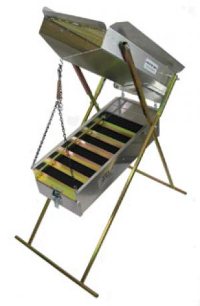Drywashers are like highbankers, but they do not use water, making them excellent tools for recovering gold from dry material in desert areas. A dry washer is basically designed to be a waterless sluice. It separates gold from sand and other waste material with pulsations of air, vibrations, and static electricity instead of running water.

The top portion of a drywasher is called a hopper and consists of a box covered with wire screen. The screen is called a "grizzly." Dry gold-bearing material is fed onto the grizzly, which is mounted at a fairly steep angle. Thinner material, such as dirt and small gravel, falls through the grizzly screen and into the hopper. Larger material, such as rocks and sticks, roll off the grizzly and back onto the ground. Material from the hopper is then fed by gravity into the riffle tray below (looks like a sluice box), through an opening in the bottom of the hopper.
The under side of the riffle tray consists of a piece of stretched cloth that allows air to pass through the bottom of the riffle tray. A fan is mounted inside the sluice box and spins as air is blown up through holes in the bottom, usually by a leaf blower or another source of compressed air. Mounted on the fan is a weight that throws the fan off balance when spinning, and vibrates the entire box. This additional vibration assists in forcing flour gold to the bottom to be trapped, whereas lighter material is blown off.
Keep the following tips in mind, and you just might see the results of your drywashing efforts pay off even better:
• Moist soils and clay cause problems, so be sure to crush lumps of clay and dry your dirt in the sun (plastic tarps are ideal) before running through your dry washer. Surface soils might seem dry, but if you dig down a few inches, you may find moisture in the soil that will cause your sand, gravel, and gold to stick together.
• Double-check all the "throw away" rocks that get stuck in the grizzly before discarding. Scanning them with a metal detector is a great way to ensure you're not tossing aside gold-laden rocks. Another time to use your detector is on old tailings piles. These ordinary looking rocks could be laced with gold, yet were completely over-looked by earlier prospectors.
• Don't limited yourself to drywashing in "proven" areas. Because of the high costs associated with inaccessibility and lack of water, most desert regions have gone largely untouched by mining operations of yesteryear. A side benefit is that you don't have to go far off the beaten path. Virgin ground can be found in washes right off major roadways.
• Keep an eye on the terrain. Areas where the greatest amount of erosion has occurred are usually the areas where the highest concentration of gold values might be found.
• One of the best locations to look for gold is where the hills meet the desert and fan out. This is where flood waters from storms drop gold in the gullies and washes. There also may be more gold traps further up on hillsides. All it takes is one good storm to change the face of a desert landscape, so drywashing after a storm can potentially uncover previously hidden gold!
Gold Buddy drywashers are made in the USA and available in four sizes— Colt, Pony, Maverick, and Stallion. Each drywasher comes with a FREE "Working the Drywasher" instructional DVD, FREE shipping in most cases, and has a 5-year manufacturer's warranty.






